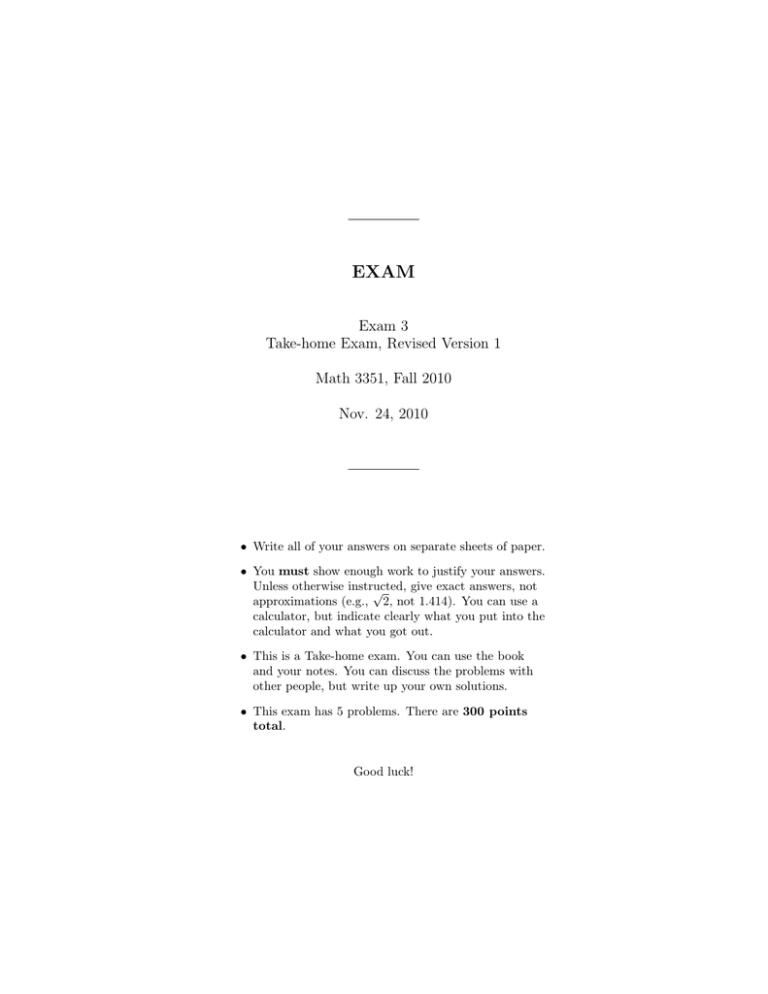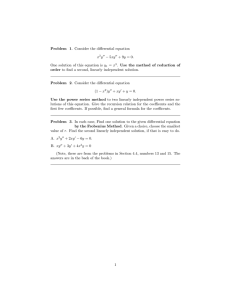EXAM Exam 3 Take-home Exam, Revised Version 1 Math 3351, Fall 2010
advertisement

EXAM Exam 3 Take-home Exam, Revised Version 1 Math 3351, Fall 2010 Nov. 24, 2010 • Write all of your answers on separate sheets of paper. • You must show enough work to justify your answers. Unless otherwise instructed, give exact answers, not √ approximations (e.g., 2, not 1.414). You can use a calculator, but indicate clearly what you put into the calculator and what you got out. • This is a Take-home exam. You can use the book and your notes. You can discuss the problems with other people, but write up your own solutions. • This exam has 5 problems. There are 300 points total. Good luck! 50 pts. Problem 1. The matrix 0 −13 1 A= 0 0 4 0 0 65 0 45 −65 13 −13 10 −9 is diagonalizable. The eigenvalues of A are 2 ± 3i. A. Find an invertible matrix P and a diagonal matrix D so that P −1 AP = D. B. Find etA . Give all of the entries of etA in real form, i.e., with no i’s appearing. Use a calculator to help out on this problem. 60 pts. Problem 2. Consider the function f (x) = 1 − x, 0 ≤ x ≤ 1. A. Find the Fourier cosine series of f (x) on the interval [0, 1]. B. For each point of [0, 1], determine what the Fourier cosine series of f (x) converges to at that point. C. Find the Fourier sine series of f (x) on the interval [0, 1]. D. For each point of [0, 1], determine what the Fourier sine series of f (x) converges to at that point. Use a calculator to do the integrals in this problem. If all of the even or odd terms of a series are zero, write the series without these terms. 1 60 pts. Problem 3. As we’ve discussed, the heat equation ∂u ∂2u =k 2 ∂t ∂x models the temperature distribution in a long, thin rod, when the lateral surface of the rod is insulated. We use x to denote the spatial coordinate along the rod, with the range 0 ≤ x ≤ L, where L is the length of the rod. If we insulate the ends of the road, the temperature distribution is modeled by the boundary value problem (3.1) (3.2) (3.3) ∂u ∂2u =k 2 ∂t ∂x ∂u ∂u (0, t) = 0, (L, t) = 0, for t ≥ 0 ∂x ∂x u(x, 0) = f (x), 0≤x≤L Here (3.2) says that the ends of the rod are insulated, and f (x) in (3.3) is the initial temperature distribution. Use separation of variables to find an infinite series solution to this boundary value problem. Give the formulas for finding the coefficients in the series from the initial condition f (x). What does the solution approach as t goes to infinity? What is the physical significance of this limiting temperature distribution? 2 70 pts. Problem 4. In class, we solved the heat equation when the ends of the rod are held at a constant temperature of zero. (We are assuming that there lateral surface of the rod is insulated.) In this problem, we consider the case where each end of the rod is held at a different constant temperature. If the left end of the rod is held at a constant temperature T1 and the right end is held at a constant temperature T2 , the situation is modeled by the boundary value problem (4.1) (4.2) (4.3) ∂2u ∂u =k 2 ∂t ∂x u(0, t) = T1 , u(L, t) = T2 , u(x, 0) = f (x), t ≥ 0. 0≤x≤L A. Find the linear function φ(x) = ax + b so that φ(0) = T1 and φ(L) = T2 . Define a function u(x, t) by u(x, t) = φ(x) for all t. Show that this function is a solution of the head equation (4.1) that satisfies the boundary conditions (4.2). This is called a steady state solution, since it doesn’t depend on time. B. Show that u(x, t) is a solution of the boundary value problem given by (4.1)– (4.3) if and only is v(x, t) = u(x, t)−φ(x) is a solution of the boundary value problem (4.5) ∂v ∂2v =k 2 ∂t ∂x v(0, t) = 0, v(L, t) = 0, (4.6) v(x, 0) = g(x) (4.4) t≥0 where g(x) in (4.6) is g(x) = f (x)−φ(x). Thus, we have reduced the problem to the case where the ends of the rod are held a constant temperature zero. C. State the solution of the boundary value problem (4.4)–(4.6), including the formula for finding the coefficients in terms of g(x). Translate this to give the solution of the original problem (4.1)–(4.3). D. What does the solution of our original problem approach as t goes to infinity? 3 60 pts. Problem 5. Again we consider a long, thin rod of length L. Instead of assuming that the lateral surface of the rod is insulated, suppose that the rod in immersed in a surrounding medium which is at temperature 0. We assume that the temperature of the medium stays constant. Assuming, as in Newton’s law of cooling, that the rate of heat transfer is proportional to the temperature difference, the equation for the temperature distribution u(x, t) in the rod will be ∂u ∂2u = k 2 − hu, ∂t ∂x where h > 0 is a constant. If we assume the ends of the rod are insulated, our situation is modelled by the boundary value problem (5.1) (5.2) (5.3) ∂2u ∂u = k 2 − hu ∂t ∂x ∂u ∂u (0, t) = 0, (L, t) = 0, for t ≥ 0 ∂x ∂x u(x, 0) = f (x), 0≤x≤L Use separation of variables to find an infinite series solution to this boundary value problem. Give the formulas for finding the coefficients in the series from the initial condition f (x). What does the solution approach as t goes to infinity? What is the physical significance of this limiting temperature distribution? 4







